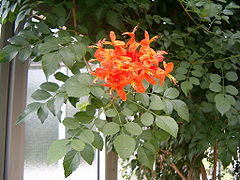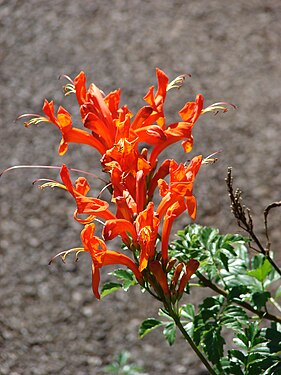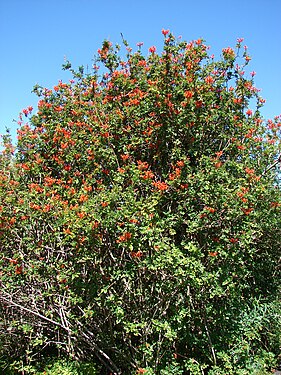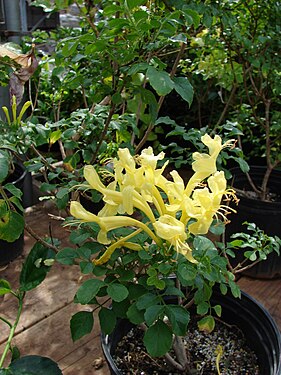Tecoma capensis
| Habit | shrub
| |
|---|---|---|
| Height: | ⇕ | 10 ft"ft" can not be assigned to a declared number type with value 10. |
| Width: | ⇔ | 7 ft"ft" can not be assigned to a declared number type with value 7. |
| Lifespan: | ⌛ | perennial |
| Bloom: | ❀ | early spring, mid spring, late spring, early summer, mid summer, late summer, early fall, mid fall, late fall |
| Exposure: | ☼ | sun |
|---|---|---|
| USDA Zones: | 9 to 12 | |
| Flower features: | ❀ | red, orange, yellow, pink |
|
Tecoma > |
capensis > |
Tecoma capensis, commonly known as Cape Honeysuckle, is a scrambling shrub which is native to Africa.
It grows to about 2 to 3 metres in height and a similar width. It is normally an evergreen shrub, but may lose its leaves in colder climates.
Leaves are evergreen to semi-deciduous in colder climates. They are opposite, slightly serrated, green to dark-green, pinnate with 5 to 9 oblong leaflets.
Flower colour ranges from orange to orange-red to apricot and are produced at different times throughout the year. In addition, these are tubular, narrow, about 3 in (7.5 cm) long. They are grouped in terminal clusters that are 4–6 in (10–15 cm) long.
Cultivation
Cape Honeysuckle has been in cultivation for many years and is often used for hedging, as it is a scrambling shrub.It can be propagated from cuttings or by removing rooted suckers during the active growth phase.
In frosty areas young plants should be protected. Cape honeysuckle can be planted in semi-shade to full sun. To keep this shrub clean and tidy, it must be pruned back in late winter to promote new growth and flowers. The application of a balanced fertilizer after pruning will enhance the growth and flowering.
Flowering time for this shrub is very erratic and often it flowers all year round. Flowers vary from red, deep orange, yellow to salmon. It is claimed by some that the yellow variety grows as a neater bush than the orange variety, but this is yet to be verified.
Propagation
Pests and diseases
Varieties
Gallery
References
External links
- w:Tecoma capensis. Some of the material on this page may be from Wikipedia, under the Creative Commons license.
- Tecoma capensis QR Code (Size 50, 100, 200, 500)





